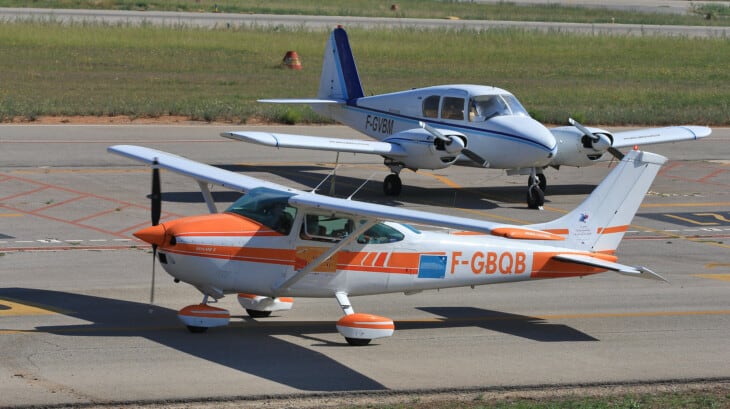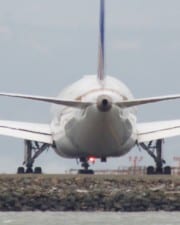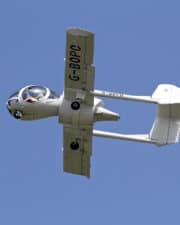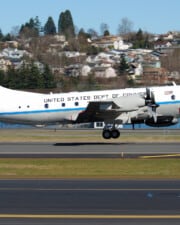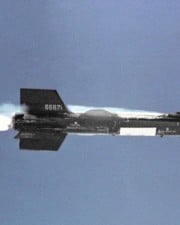When it comes to aircraft design, the wings are arguably the most important part. Aside from the aerofoil, the wing placement is essential to an aircraft’s handling characteristics, specs and overall success. Though there are a few places aircraft engineers can place the wing, there are generally only two that they go for: at the bottom of the fuselage or at the top. So which is better?
Low wing aircraft are considerably more common. They offer greater upward visibility and fuel efficiency. High wing aircraft, however, are far better for cargo and seaplane operations whilst also offering greater lower visibility.
If you’re looking to buy your first aircraft, and are debating between which aircraft type you want, this article should give you all the pros and cons of each wing placement, and hopefully help you make the decision that best suits your needs!
What is a High Wing Aircraft?
As the name would suggest, a high wing aircraft is any aircraft whose wing is located on the top of the fuselage. Typically, the top surface of the wing blends into the top of the fuselage, though they do occasionally have them separately above the top of the fuselage.

While several early aircraft experimented with high wing designs as a part of a bi- or triplane design beforehand, the first true high wing aircraft was the French-built Antoinette IV, built and designed by Léon Levavasseur (who also invented the now-famous V8 engine) in 1908.
Though only one Antoinette IV was ever built, and never completed the first aerial crossing of the English Channel, the Antoinette IV’s high wing design earned it acclaim across the world at the time, inspiring a slew of high wing aircraft that saw action during WWI and beyond.
High wing designs have continued to be used ever since.
Today, they are most commonly associated with general aviation and trainer aircraft like the Cessna 172 and Piper Pacer, or with various modern and historical amphibious aircraft like the Icon A5 or Hughes H-4 Hercules.
In truth, they are also incredibly common cargo aircraft, with many of the world’s largest aircraft having high wing designs, such as the C-5 Galaxy, Antonov An-225 Myria and Scaled Composites Stratolaunch.
Most commercial fixed wing drones similarly employ high wing designs, as these allow them to maximize flight times for their battery size without compromising range due to high wing designs having better lift characteristics.
What is a Low Wing Aircraft?
Likewise, a low wing aircraft is an aircraft whose wing is mounted on or near the bottom of the fuselage. Low wing aircraft are by far the most common wing type among monoplane designs, owing chiefly to their overall simplicity, for both large and small aircraft alike.

The placement of the wing on low wing aircraft varies considerably. Some employ an offset wing design, whereby the top of the wing is perpendicular to bottom of the fuselage, while others employ a blended design where the bottom of the wing is perpendicular to the bottom of the fuselage.
Still more, some others even use a mixture of both to create a wing with a rather unique airflow, though these are incredibly uncommon in modern aviation.
The first aircraft to use a low wing design was the Etrich Taube. Designed in 1909 and first flown in 1910, the Taube became one of the first military aircraft ever built, being used as a reconnaissance aircraft by the German and Austro-Hungarian Air Forces long before WWI broke out.
Though the Taube inspired several subsequent low wing monoplane designs that were used as observation aircraft during WWI, such designs fell out of fashion after the war in favor of high wing and biplane designs until the late 1920s and early 1930s.
Since then, low wing configurations have been used on all types of aircraft, from general aviation aircraft to airliners to air racers. They are so versatile, low wings can even be found on spacecraft, such as the Space Shuttle and Buran programs.
How Are High Wing And Low Wing Aircraft Similar?
The main similarity between high and low wing aircraft is that the fundamental principles remain the same. Both types of wings generate lift and are susceptible to drag, with the amount of both mostly being the same (assuming the same aerofoil, flaps etc. are used).
Likewise, both types are controlled the same way; by flaps, ailerons, elevators, rudders and slats (if applicable).
Both high and low wing configurations are found on all types and sizes of aircraft, from something as small as a Cessna 172 or a Piper Tomahawk, to something as large as a Boeing 747 or Lockheed C-5 Galaxy.
How Are High Wing And Low Wing Aircraft Different?
Most obviously, high wing and low wing differ in where their wings are placed. High wings have their wings mounted at the top of the fuselage, whilst low wing aircraft have their wings mounted at the bottom of the fuselage.
Because of this, their centers of gravity also differ. High wing aircraft tend to have a higher center of gravity than low wing aircraft, simply due to the mass of the wings being higher up the fuselage.
In turn, this affects the two aircrafts’ aerodynamics.
The higher center of gravity on high wing aircraft, as well as the relative proximity of the wings to the elevators, makes them harder to stall. And in the event they do begin to stall, it is much more noticeable, giving pilots a high chance of recovering from an impending stall.
Indeed, the aircraft with the world record for the slowest stall speed, the Ruppert Archaeopteryx, is a high wing design, and stalls at an incredibly slow 30 km/h (19 mph)!
Similarly, the low position of the wings on low wing aircraft allows them to enter ground effect earlier, enabling them to glide for longer and land and take off from shorter runways than their closest high wing alternative.
High and low wing aircraft also differ in terms of their fuel systems. To move fuel from the tanks to the engines, low wing aircraft rely on fuel pumps, which need to be changed and maintained regularly to avoid engine cut outs.
High wing aircraft, however, can use gravity to feed fuel to the engine, reducing maintenance costs due to fewer moving parts.
What’s Better About High Wing Aircraft?
The main thing that’s better about high wing aircraft is their greater lower visibility. Due to the wings being located above the fuselage, pilots (and by extension passengers) have a better field of vision of what’s below them.

This comes in particularly handy when in turns, as the pilot is more clearly able to see their surroundings, without risking missing something due to the wing blocking their field of vision.
It’s this greater visibility that also makes high wing aircraft the preferred option for aerial photography and sightseeing flights, as photographers/passengers are able to get the best view(s)/photo(s) without compromising lateral stability, thus producing a much higher quality shot for the photographer than if they had taken the picture in a bank as they would in a low wing aircraft.
Similarly, high wing aircraft have long – and almost exclusively – excelled as seaplanes and other types of amphibious aircraft.
This is chiefly because their higher wings give them a greater clearance from the water, reducing the likelihood of them hitting the water and getting damaged, and provides a way to mount pontoons for increased stability if the aircraft is larger.
It also provides a place to mount the engines to similarly protect them from water damage.
From an aircraft design perspective, high wing aircraft also benefit from having a greater lift-to-drag ratio than their low wing counterparts (generally). This is primarily due to them having longer wingspans than comparable low wing aircraft, which provides a greater surface area to generate lift.
This makes high wing configurations great for cargo aircraft, as they are able to carry up to 25% more weight than if their design had a low wing.
This 25% higher payload capacity allows potential operators to benefit from increased revenues and decreased average item costs without needing to fly additional flights or compromise safety.
The other main benefit of utilizing a high wing design on a cargo aircraft is the cargo door. Those on high wing aircraft tend to be much larger than those on low wing aircraft, and placed further to the front or rear of the aircraft.
A larger cargo door allows these aircraft to take outsized cargo payloads other aircraft can’t, whilst a cargo door at the nose or positioned more to the rear allows ground crews to position such outsized cargo in a way that maximizes space (allowing for more cargo if weight limits permit it) and for a more equally balanced aircraft, aiding overall flight performance and control.
What’s Better About Low Wing Aircraft?
The main selling point of low wing aircraft is their versatility. Due to many of the below points, low wing designs are used on all types of aircraft, large and small, fast and slow, mass produced and experimental.

The same cannot be said for high wing aircraft. At least, not in the same proportions.
Where high wing aircraft offer better lower visibility, low wing aircraft offer better upward visibility. This makes them great for all types of flying, as it allows the pilot to see arguably the most dangerous place another pilot can come from: above them.
Low wing aircraft have low centers of gravity, which gives them better and more responsive roll characteristics. This makes them perfect for general aviation and aerobatic uses, as well as commercial aircraft who often need such controls in order to land and takeoff from the most remote and hard to reach airports.
Similarly, in a direct comparison between the same aircraft designs – one with a low wing and the other with a high wing – the low wing version will be more fuel efficient; often by upwards of 20%, as they are more easily able to glide through the air, thus reducing fuel consumption.
In part due to this, low wing designs almost always have faster cruising speeds, as the fuel savings can be translated into higher volumes of fuel flowing through the engine(s), making the propeller spin – and propel the aircraft – faster.
But perhaps the main reason why low wing aircraft tend to be more common than their high wing counterparts is their cabin space.
Indeed, high wing aircraft generally have smaller cabins, as the top part of the cabin has the wing spar running through it to connect both wings together, which needs to be protected from deliberate/accidental damage by ensuring it is 100% sealed from the cabin.
Low wing aircraft, on the other hand, have the wing spar running underneath the cabin floor, which allows for a taller cabin, and thus greater cabin volume.
This means that taller passengers have greater headroom to navigate the aircraft, a higher volume (but not weight) can fit in the cabin and/or allow for greater in-flight storage area, namely through the overhead bins we see on most commercial airliners.
Conclusion
All in all, whether you should choose a low or a high wing aircraft wholly depends on what you intend to use the aircraft for, where you intend to fly it and the overall characteristics you are looking for.
For any kind of amphibious, cargo or sightseeing use, high wings are undoubtedly the way to go, as they fit those roles far better than most low wing alternatives.
However, for any role where speed and overall fuel efficiency is required, such as in commercial aviation, low wings are a far better fit.
The same can also be said for anything where control or overall aerodynamic stability is a must, eg. aerobatics.
Related Posts
